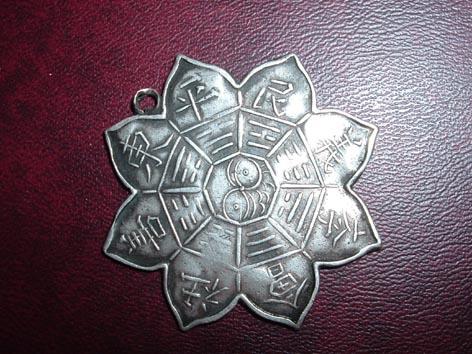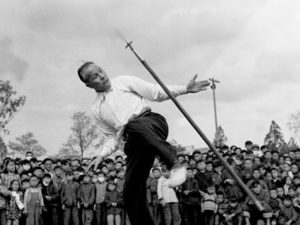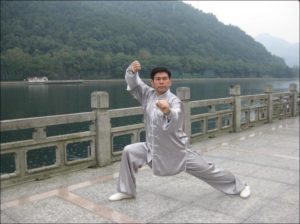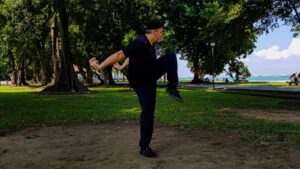The Bailianjiao 白蓮教 “White Lotus Sect” was a millenarian movement with Buddhist traditions that several times in history ignited large-scale popular uprisings against the ruling dynasties.
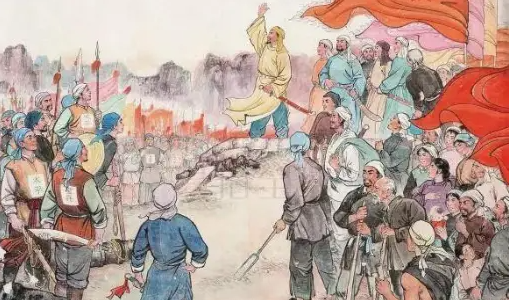
The religious background of the White Lotus Sect goes back to the Pure Land School (Jingtuzong 淨土宗) whose oldest patriarch, Huiyuan 慧遠 (334-416 CE), founded White Lotus Societies (bailianshe 白蓮社 or lianshe 蓮社 “Lotus Societies”) in the Donglin Monastery 東林寺 near Mt. Lushan 廬山 (today in Jiangxi). During the Northern Song period 北宋 (960-1126), White Lotus societies spread over all southern China. They were supported by monasteries as well as by rich landowners.
In the mid-12th century the monk Cizhao 慈照 (c. 1096-1166, worldly name Mao Ziyuan 茅子元) founded a new Buddhist School out of these societies, the White Lotus School (bailianzong 白蓮宗). The adherents of this school venerated the Amitābha Buddha (Amita Fo 阿彌陀佛) and observed the five Buddhist rules of discipline (wujie 五戒: not killing, not stealing, not indulging in pleasures, not speaking bad words, not drinking) that were also a focal point of the Pure Land teaching. Mao Ziyuan also adopted the method of the Tiantai School 天台宗 to illustrate the teachings of the Buddha by drawings and pictures, which made it much easier to attract a wider followership. He also compiled confessional rules for daily worship, the Bailian chenchao chanyi 白蓮晨朝懺儀. In order to connect the scattered Lotus Societies he erected a Lotus Repentance Temple (Lianchantang 蓮懺堂) on the shores of Lake Dinghshan 淀山湖 near Kunshan 昆山, Jiangsu, adopted the title of Master (daoshi 導師), and assembled an auditorium to which he preached the teachings of the White Lotus School.
The newly founded White Lotus School was officially forbidden, and Mao Ziyuan had to leave Kunshan for Jiujiang 九江 (today in Jiangxi). Yet because the teachings of his school were quite simple and easy to understand, the White Lotus School attracted a lot of adherents not only in the Lower Yangtze region, but also in other parts of China. When the Mongols founded the Yuan dynasty 元 (1279-1368), the White Lotus School was officially acknowledged and even sponsored by the government. It therefore became such an important branch of Buddhism that some believers even participated in the propagation of the faith as “Lotus people” (liandaoren 蓮道人) in private temples at home (tang’an 堂庵). Because these “householders” retained the everyday clothes and did not shave their heads, they were also called “long-haired monks” (faseng 髮僧). Their private temples became such important clerical institutions that sons commonly inherited their father’s duty of managing these semi-public prayer halls.
The most popular deities were the Amitabha Buddha, the Bodhisattva Avalokiteśvara (Guanshiyin Pusa 觀世音菩薩), and the Mahāsthāmaprāpta (Dashizhi Pusa 大勢至菩薩). These three were subsumed under the designations Three Amida Saints (Amituo sansheng 阿彌陀三聖), Western Saints (Xifang sansheng 西方三聖), Three Amida Venerables (Amituo zansun 阿彌陀三尊; note: the Eastern Saints are “Medicine Master” Bhaiṣajyaguru 藥師佛, the “Sunlight Bodhisattva” Sūryaprabha, Riguang Pusa” 日光菩薩 and the “Moonlight Bodhisattva” Candraprabha, Yueguang Pusa 月光菩薩). The adherents prayed for health and fortune, and rich believers sponsered the building of official institutions like streets, bridges or temples. The owners of private temples often belonged to the most wealthy families in the cities and had close ties to the government.
Evolution and Development
In the course of time the teachings of Mao Ziyuan changed somewhat, especially among the common populace that developed their own ideas of the White Lotus religion. It was a very popular belief that the Amitabha Buddha would descend from Heaven as a redeemer of mankind. Adherents of this millenarian branch of the White Lotus School assembled at night and soon began to rise weapons against the Yuan dynasty in order to hasten the advent of the Amitabha Buddha or the Bodhisattva Maitreya (Mile Fo 彌勒佛). In 1308 therefore, the Yuan court prohibited the White Lotus School in total and was only allowed open confession again a few years later. In 1322 it was declared illegal again because more and more White Lotus societies had begun to fight openly against local governments. The most important leaders of White Lotus rebel societies were Han Shantong 韓山童 (d. 1351), Liu Futong 劉福通 (1321-1363), Xu Shouhui 徐壽輝 (c. 1310-1360) and Zou Pusheng 鄒普勝. Their adherents fought to topple the Yuan dynasty and to welcome the “King of Brilliance” (mingwang 明王), i.e. the Maitreya Boddhisattva. The White Lotus societies constituted indeed an important reason for the downfall of the Yuan dynasty.
Based on this experience, the White Lotus School was prohibited under the Ming dynasty 明 (1368-1644), and for good reasons, because the foundation of the new dynasty was no reason to cease belief in the advent of a redeemer deity. During the early Ming period, White Lotus uprisings in all provinces were successfully put down. The various secret White Lotus societes later changed their names and were so not easily to be recognized as White Lotus offsprings. They adopted names like Teaching of the Golden Zen or dhyana (Jinchan jiao 金禪教), Non-Activity, i.e. Nirvana (Wuwei jiao 無爲教), Dragon Flower (Longhua jiao 龍華教), “Aware of the Voidness (Wukong jiao 悟空教), Back to Origins (Huanyuan jiao 還源教), Perfectness and Directness (Yuandun jiao 圓頓教), Vast Yang (Hongyang jiao 弘陽教), Maitreya (Mile jiao 彌勒教), Pure Voidness (Jingkong jiao 淨空教), Great Completeness (Dacheng jiao 大成教), Three Yang (Sanyang jiao 三陽教), Origin of the Primordial Chaos (Hunyuan jiao 混源教), Sensing Perfume (Wenxiang jiao 聞香教), or Way of the Arhat (Luodao jiao 羅道教).
Because they were not allowed to establish a central authority, their rituals and liturgies differed from each other, as well as the central deities, albeit the most important deity for most White Lotus sects was the Maitreya. From the Zhengde reign-period 正德 (1506-1521) on a new deity appeared among White Lotus adherents, namely the Wusheng Laomu 無生老母 “Birthless Old Mother” that was seen as a form of transcendent Buddha that never incarnated but ever existed without coming into being or transforming into a non-being form. She would nevertheless come down upon earth in the human shape of children, would protect them from harm and guide them safely back to Heaven, the “home of the true voidness” (zhenkong jiaxiang 真空家鄉). The different societies also used different writings to propagate their faith.
The behaviour of these various societies toward the government was therefore also not stringent. While some cooperated as normal religious institutions, others were openly opposed towards the local government. The adherents of the latter societies came mainly from the lower strata of society, like landless peasants or unemployed persons. In 1420 Tang Sai’er 唐賽兒 (b. 1399) rebelled against the Ming government, in 1622 Xu Hongru 徐鴻儒 (d. 1611). The most important White Lotus society during the late Ming period was the Wenxiang School (also called “Mahayana” Dasheng School 大乘教) that had been founded by Wang Sen 王森 and Wang Haoxian 王好賢 in Luanzhou 灤州. They managed to attract the support even of more fortunate persons so that they were able to purchase large tracts of land and acted as employer to peasants and workers.
During the Qing period 清 (1644-1911) the situation even more aggravated, so that there were more than one undred various branches of the White Lotus school. In 1774 the White Lotus leader of the Pure Water Society (Qingshui jiao 清水教), Wang Lun 王倫 (d. 1774), rose in rebellion in the province of Shandong. Between 1796 and 1804 the “heretic” (xiejiao 邪教) Lotus societies in the border region of the provinces Hunan, Hubei, Sichuan, Shaanxi and Gansu aroused a protracted local war against the Qing authorities. This was the first large-scale popular uprising that initiated the downfall of the Qing dynasty, although this had in many cases not been the main objective of the rebellions. In 1813 the Heavenly Order Society (Tianli jiao 天理教) under Li Wencheng 李文成 (d. 1813) disturbed the local governments in northern China. Only in the second half of the 19th century the leaders of White Lotus societies adopted political plans.
The White Lotus Rebellion 1796-1804
In the densely forested border area between the provinces Hubei, Sichuan and Shaanxi, a lot of homeless peasant refugees (liumin 流民, see also shed people) had gathered to escape the grip of landowners, creditors and tax collectors. Until 1772 and 1773 already several hundred thousand persons belonged to these outlaws, and numbers constantly rose by immigrants from the provinces of Henan, Anhui and Jiangxi. In the bad climate of the region that made agriculture a scarcely profitable business, the inhabitants made their lives by working in the land clearing business, in the paper industry, or in the smithry business.
Under such hard conditions, a lot of people resorted to the harbour of religion and became followers of the many secret White Lotus societies. A saviour deity that only required people living in a modest and cooperative way with each other (sharing income, sharing food, mutual support in case of need) provided a strong appeal for the White Lotus leaders. The first leader proclaiming the coming of a new age was Fan Mingde 樊明德 in Henan. Liu Song 劉松, Liu Zhixie 劉之協 and Song Zhiqing 宋之清 in Hebei, Sichuan and Anhui even prognosticated the return of the Ming dynasty (they used the character code Niu-Ba 牛八 for the character of the surname of the Ming rulers, Zhu 朱). In 1795 a collective uprising was carefully planned, and societies willing to participate were equipped with swords and gunpowder.
The local government instantly took harsh measures to catch and arrest all adherents of the White Lotus societies and thereby even intensified the resistance of the White Lotus leaders against government and dynasty. In February 1796 Zhang Zhengmo 張正謨 and Nie Jieren 聶傑人 rose in rebellion in the region of Yidu 宜都 and Zhijiang 枝江 in Hubei. A month later Wang Cong’er 王聰兒 and Yao Zhifu 姚之富 rebelled in the region of Xiangyang 襄陽. The various rebel societies did not cooperate with each other but fought for themselves, barricaded behind timber palisades or fortified villages to resist the local gendarms. Only the troops of the Xiangyang rebels were able to build up a large army that was able to challenge the Qing troops in the field.
Half a year later White Lotus societies in Sichuan joined the rebellion under the leadership of Xu Tiande 徐添德 in Dazhou 達州 and Wang Sanhuai 王三槐 and Leng Tianlu 冷天祿 in Dongxiang 東鄉 (modern Xuanhan 宣漢). In February 1797 the rebel armies of Hubei spread out and looted all the region and began wandering to the neighbouring provinces. The regular Qing troops were only able to persue them and was not able to root out any base of the locust-like White Lotus army. In July the Qing finally managed to encircle the rebel base in Sichuan, so that the Hubei rebels approached for relief. Although Wang Cong’er was talented enough to build up effectively brigades under different commanders, his soldiers were not able to cooperate with each other, so that each company after the other was repelled and disintegrated.
In March 1798 the Hubei rebels were trapped by the Qing army near Yunxi 鄖西, and its leaders died. The Sichuan rebels likewise had suffered great losses. Yet the files of the rebels were constantly filled with new recruits, and the local population supported the insurgents, provided them with food and gunpowder, carried their supplies and scouted them through the mountain hills. In early 1800 the rebels were nevertheless again defeated near Jiangyou 江油 in Sichuan.
The Qing generals had adopted a new method to cut the rebels off their supplies of material and recruits. The government had palisades built for villages and forcibly settled down the peasants of the hilly lands into these defense compounds (zhaibao 寨堡, cunluo 村落). All economic activities were to take place within these compounds. At the same time, village militia (xiangyong 鄉勇) were recruited and trained to fight against White Lotus “bandits”. These measures helped to deprived the White Lotus rebels of food and supplies and took them away the necessary manpower to staff their army. The Qing army step by step encircled the last rebel groups in the triangle of the provinces Hubei, Sichuan and Shaanxi, where the rebellion had begun. In late 1804 the war against the White Lotus heretics could be declared as terminated.
The nine-years long White Lotus war had devastated a large number of districts in Central China. It had cost the lives of countless civilians and regular troops, including more than 400 high officers, and consumed more than 200 million liang/tael, which corresponded to four times the annual revenues of the state treasury. It had proved the inability of the Qing government to cope effectfully with large-scale popular uprisings and the wide-spread corruption among both the civilian government and the military establishment.
The Heavenly Order Society 1813
The Heavenly Order Society was one of the few White Lotus movement of late imperial China that managed to associate different societies into one. It came into being by the cooperation of the Eight Trigrams Society (Bagua jiao 八卦教, also called Nine Palaces Society, Jiugong jiao 九宮教), the Flowering Society (Ronghua jiao 榮華會), and the White Sun (Baiyang jiao 白陽教), Red Sun (Hongyang jiao 紅陽教) and Blue Sun (Qingyang jiao 青陽教) societies. The most important leaders of this new united society were Li Wencheng 李文成 and Feng Keshan 馮克善 from Henan and Lin Qing 林清 from Daxing 大興 near Beijing.
The society was organised in eight groups (corresponding to the eight trigrams). The mainly used scripture of the adherents was the Sanfo yingjie tongguan tongshu 三佛應劫統觀通書, and they venerated the Birthless Old Mother, but also the sun. They believed in the three progressive eons (sanji 三際), calling the past “dimension-less extreme” (wuji 無極), the present the “greatest extreme” (taiji 太極), and the future “august extreme” (huangji 皇極), but also prognosticated the decline of the Red Sun (hongyang 紅陽) and the ascent of the White Sun (baiyang 白陽), thus favouring the rise of a new dynasty. In 1813 the Heavenly Order Society rose in rebellion against the Qing dynasty and devastated the provinces of Henan, Shandong and Zhili. Some groups even invaded the Imperial City.

